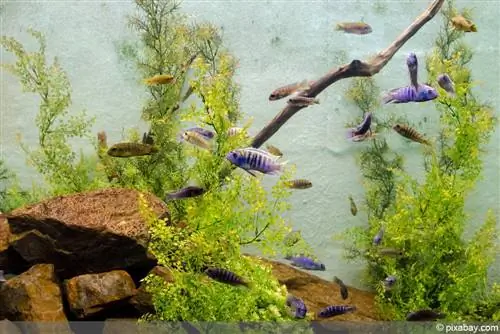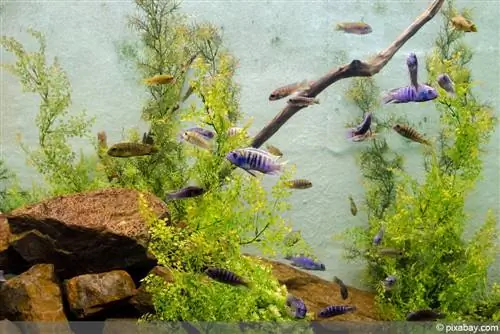- Author admin [email protected].
- Public 2023-12-17 03:39.
- Last modified 2025-06-01 06:48.
The problem often resolves itself when the silicate is used up. Since new silicate is constantly added through fresh water, there can always be problems with these algae.
Identifying diatoms
Diatoms can be recognized by a brownish, greasy coating on the substrate, on objects, on windows and, above all, on plants. This coating is often riddled with oxygen bubbles. Because of their brown color, diatoms are sometimes referred to as brown algae, but this is incorrect. Diatoms form a silicate shell. To do this you need silica.
In order to successfully combat diatoms, a few steps are necessary. First of all, the causes of the infestation must be found, because combating it depends on where it comes from. The causes must be eliminated.
Finding out the causes of diatoms
Diatoms often appear in newly set up aquariums. This is because the bacterial cultures have not yet developed sufficiently and the new plants are not yet fully established. Another criterion for appearance is light. Diatoms don't like it that bright, they prefer the shade of plants and poorly lit pools.
However, the main reason for their growth is an excess of nutrients in the water. Silicic acid is mainly present in fresh water. Over time this is converted and becomes SiO2. This can no longer be used by the algae. This explains why the algae disappear on their own after a while. In new aquariums this process takes longer, in older aquariums it happens faster. This is also the reason why the addition of silica when changing the water is of little importance.
A high phosphate value also plays a major role in the spread of diatoms. Almost all types of algae like phosphate, diatoms are no exception. If there is too much phosphate in the water, diatoms will form even in established aquariums. Sparse plant growth and very hard water are also triggers.
- Test water values - take steps to prevent exceedances
- Check lighting, there may be too little light, give more light
- Check care measures, carry out cleaning if necessary
Fight diatoms
There are different ways to kill diatoms. One is often not enough. It is usually the sum of measures. Of course, the conditions have to be changed so that the algae can no longer find food.
Manual Removal
Diatoms can be easily wiped off smooth surfaces. Regardless of whether it's windows, objects or plants, wiping is enough. An aquarium blade is suitable for the slices. Things get more complicated on the ground. The algae should be vacuumed out here, simply with a hose, right when you change the water. The affected layers can also be washed out, but this is complicated and time-consuming.

After cleaning, most of the water should be replaced in order to remove the remains and algae floating in the water from the aquarium.
Reduce silica levels
If you are setting up a new aquarium, you should not use tap water straight. It is better to mix it with osmosis water. Osmosis water is created when tap water is forced through a membrane under high pressure. It is an intensive filtering process in which all components are removed from the water, including the minerals. In order to produce osmosis water, a filter or a filter system is required. Everyone has to decide for themselves whether it is worth it just to “clean” the water in the aquarium. However, these filters are now available in numerous households.
If you already have an aquarium and the water there is free of diatoms, you can take water from it and put it in the new tank. It is then mixed with regular tap water. This speeds up the running in of the new aquarium because the silica can convert more quickly. The algae are deprived of nutrition.
Water change from 25 to 50 percent
Reduce phosphate content
Algae usually only appear when the phosphate content is 0.25 mg per liter of water. Sometimes such high levels occur in drinking water. Then osmosis water is really a good choice, at least for the aquarium. If it is not the fresh water that is causing high values, the reason must be found out. There are various causes. Often there are simply too many fish in the tank. These ensure high values through their feces. In addition, feeding is often too plentiful. Food contains nutrients. It sinks to the bottom and decomposes over time. This is how the nutrients are released. Fast-growing plants help lower the levels. They should be present in abundance in the aquarium.
If it is not enough to reduce the fish population and the amount of food, use plants and increase the lighting intensity, phosphate binders can help. They are offered in large numbers in stores. It is important to follow the dosage instructions and choose the most natural remedy possible.
- Replace water, 25 to 50 percent
- Check fish population, remove fish if necessary
- Check the amount of food. Anything the fish haven't eaten within a maximum of 10 minutes is too much. Therefore feed less
- Use fast-growing aquatic plants
Prevention

A lot can be done to prevent it, starting with choosing the most favorable location, choosing a few residents, planting numerous suitable plants, operating a suitable filter, ideal lighting, changing the water regularly, and checking the water values frequently and cleaning. Mouth-sucking fish, for example, are hard-working helpers in fighting diatoms.
- Location not too dark, but definitely not in the sun, this encourages other algae
- Fish stock - not too many fish or other residents. Lots of fish - lots of feces. There are also special types of fish that bring a lot of nutrients into the water through their feces. Specialist shops can certainly help.
- Plant stock - the more plants, the more nutrients are used for growth. These are no longer available to the algae.
- Filter - appropriate filters clean the aquarium water
- Lighting - try slightly brighter light, but not more than 10 to 12 hours, otherwise other types of algae will be encouraged
- Water change - during normal operation, a water change every two to three weeks is sufficient. If algae appear, remove water weekly and add new water. Think about an osmosis filter.
- Check water values - not just in an emergency, but regularly. In this way, deviations are noticed in good time and you can take countermeasures
- Cleaning - clean with every water change
Conclusion
In newly created aquariums, diatom infestation often occurs after a short time. That's not worrying. There is no need to take action against it. After a few weeks this goes away, then the diatoms have used up the silicate and die without food. New silicate is added when the water is changed, but once the pool has settled in, this is no longer a problem. If there is an increased infestation of diatoms during ongoing operations, it must be checked why this is happening. Often there is too little light. This deficiency can be easily remedied. Things are a little more complicated when there is an oversupply of nutrients. Then the conditions must be changed so that they are reduced.






